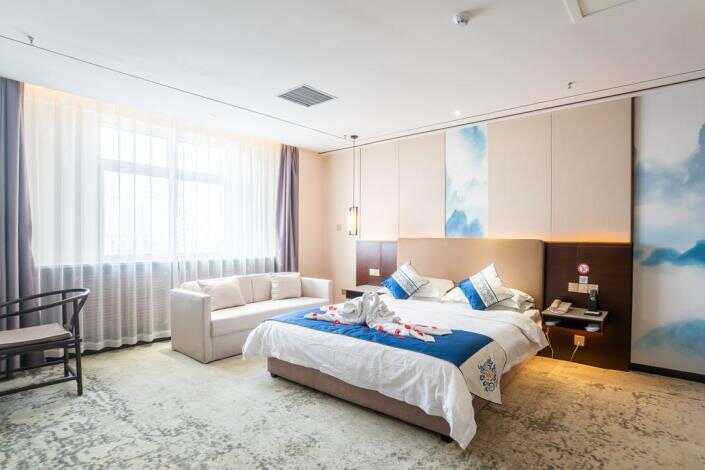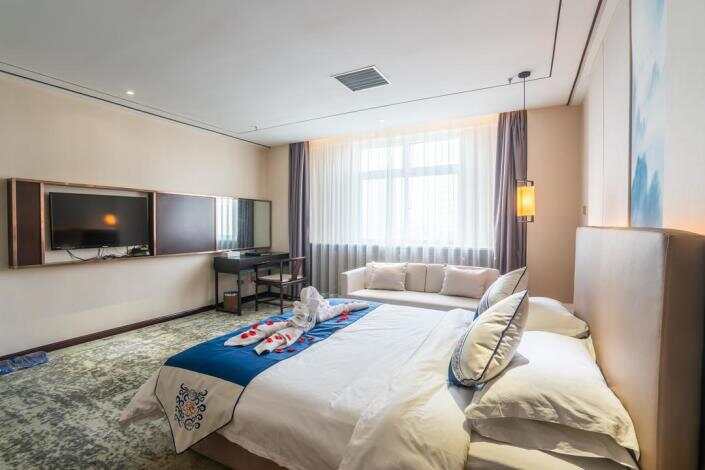

In the dynamic and competitive hotel industry, furniture plays a pivotal role beyond mere aesthetics—it is essential to curating a comfortable and memorable guest experience. As guests increasingly prioritize comfort, functionality, and style, the thoughtful selection of hotel furniture becomes integral to creating exceptional environments. This guide explores how to harmonize comfort, design, and brand assurance when selecting hotel furniture, helping hotel owners design guest rooms that are both inviting and supremely comfortable.
Understanding Hotel Brand and Design Style:
Furniture should seamlessly align with the hotel’s overall brand image. A cohesive design fosters consistency and enhances the guest experience. For design inspiration and industry standards, the American Hotel & Lodging Association (AHLA) provides valuable resources.
Consistency with Hotel Theme:
The furniture must complement the hotel’s theme, creating a distinctive, aesthetically pleasing environment that reinforces the hotel’s identity.
Material Selection and Craftsmanship:
High-quality materials and excellent craftsmanship ensure long-lasting furniture, reduce maintenance costs, and retain aesthetic appeal. To learn more about durability standards in furniture, refer to the guidelines published by ASTM International.
Furniture Usage and Lifespan:
For high-traffic areas, durable, high-quality pieces are essential for long-term value.
Ergonomics and Comfort:
Prioritize ergonomic design in guest room furniture to ensure an enjoyable experience. For health and safety guidelines on ergonomics, the Centers for Disease Control and Prevention (CDC) offers relevant insights.
Beds, Sofas, and Seating:
Exceptional seating and lounging options directly correlate with guest satisfaction.
Furniture Dimensions and Adaptability:
Selecting the right size and adaptable pieces can maximize space efficiency, improving room layout and overall guest comfort.
Optimizing Available Space:
Strategic furniture choices ensure that every square inch is effectively utilized.
Materials That Are Easy to Clean:
Choosing easy-to-maintain materials helps hotels uphold high hygiene standards and reduce upkeep time and costs. Learn more about maintenance best practices from the U.S. Environmental Protection Agency (EPA).
Simplified Furniture Maintenance:
Opt for designs that are straightforward to maintain, keeping long-term costs low.

Balancing Quality and Budget:
Set a clear budget to balance quality with financial considerations, ensuring that you do not compromise on comfort or aesthetics.
Avoiding Budget Overruns:
Careful selection throughout the procurement process prevents financial strain.
Monitor Furniture Market Trends:
Stay informed about current trends to align your furniture choices with evolving guest expectations. For statistical insights and market data, consider resources like Statista.
Reputable Furniture Suppliers:
Work with suppliers known for stringent quality standards.
Eco-Friendly Materials:
Prioritize sustainable materials that align with the hotel’s eco-conscious image and support global sustainability efforts. Explore sustainable certification options through the Forest Stewardship Council (FSC).
Furniture Lifecycle Impact:
Assess the lifecycle of furniture to choose products that offer both environmental and economic benefits. Additional guidance on sustainability practices can be found at the U.S. Green Building Council (USGBC).
Furniture Customization:
Customized furniture allows you to create unique solutions tailored to your hotel’s design and spatial needs.
Flexibility for Future Renovations:
Consider furniture that can adapt as your hotel evolves over time.
Furniture Safety Standards:
Ensure that all furniture meets local and national safety regulations. For detailed standards, refer to ASTM International and the Americans with Disabilities Act (ADA) for accessibility requirements.
Material Environmental Regulations:
Compliance with environmental regulations contributes to your hotel’s sustainability efforts.
Reputable Brands and After-Sales Services:
Select well-established brands known for quality and reliability. Reliable after-sales services, including maintenance and repair support, ensure long-term satisfaction with your investment.
Visiting Supplier Showrooms or Factories:
Inspecting manufacturing processes firsthand helps confirm product quality.
Requesting Furniture Samples:
Testing samples allows you to ensure that the furniture meets your functional and aesthetic requirements.
Cultural Aesthetics:
Incorporate local materials, colors, and designs to create an authentic guest experience. For insights on integrating cultural aesthetics, see resources provided by local heritage organizations or regional design councils.
Smart Furniture Options:
Modern guests appreciate tech-savvy environments. Integrating smart features like USB charging ports and smart lighting can significantly enhance convenience. For examples of smart technology in hospitality, refer to the Smart Hotels Guide.
Accessible Design:
Furniture must accommodate guests with diverse needs. Prioritize designs that comply with accessibility standards to create an inclusive environment. More information is available at the ADA website.
Universal Design Principles:
Embrace principles that ensure usability by all guests, enhancing overall satisfaction.

Selecting the right hotel furniture involves much more than choosing stylish pieces—it requires a balanced approach that considers comfort, quality, functionality, space optimization, and sustainability. By incorporating cultural sensitivity, technological innovation, and accessibility, hotel owners can create spaces that not only serve their functional purpose but also enhance the overall guest experience. Paying close attention to these details helps hotels stand out in a competitive industry and leaves a lasting impression on guests.
For further insights on industry standards and sustainable design practices, visit:
American Hotel & Lodging Association (AHLA)
Email cannot be empty
Password cannot be empty
Email format error
Email cannot be empty
Email already exists
6-20 characters(letters plus numbers only)
The password is inconsistent
Email format error
Email cannot be empty
Email does not exist
6-20 characters(letters plus numbers only)
The password is inconsistent